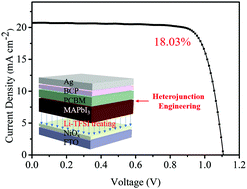Surface treatment via Li-bis-(trifluoromethanesulfonyl) imide to eliminate the hysteresis and enhance the efficiency of inverted perovskite solar cells†
Abstract
Recently, inverted planar perovskite solar cells (PSCs) with a p–i–n configuration have drawn tremendous interest due to their high efficiency and reduced hysteresis. It has been demonstrated that p–i–n planar PSCs employing organic hole transport materials can obtain excellent photovoltaic performance, but their high cost and poor stability have restrained their further development. Herein, we employ Li-bis-(trifluoromethanesulfonyl) imide treated NiOx (Li-treated NiOx) as an excellent and robust hole transport layer (HTL) for fabricating highly efficient and stable PSCs. Compared to the pristine NiOx, the Li-treated NiOx exhibits enhanced electrical conductivity and better band alignment, enabling fast and efficient hole transport as well as exciton separation. The PSC with a Li-treated NiOx HTL shows a significantly improved fill factor and efficiency (from 0.75, 14.46% to 0.79, 17.09%) as well as less hysteresis with satisfactory long-term stability. Furthermore, we obtain a champion efficiency of 18.03% via graded heterojunction engineering. Therefore, our results suggest Li-treated NiOx film is an effective and promising hole transport material for efficient PSCs.



 Please wait while we load your content...
Please wait while we load your content...